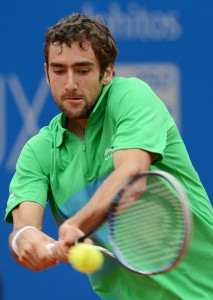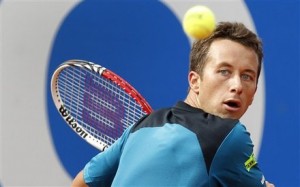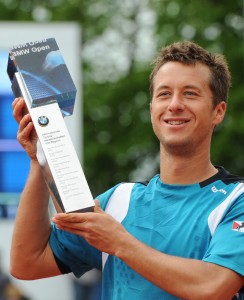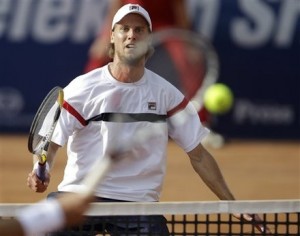Munich, Final
(4) Kohlschreiber d. (3) Cilic, 7/6 6/4
The theme of the week in Munich was flashy one-handed backhands launching winners up the line – there’s an opportunity for a logo redesign – counterpointed by Marin Cilic’s inexorable progress to the final. It is unfair to say that Cilic is one-dimensional, since no player truly is, but he certainly has fewer dimensions than the players he’d seen off so far.  But when your primary dimension is hitting the ball flat and hard to parts of court where your opponent isn’t, variety is a mere vanity, and wholly superfluous. The real problems come when your flat, hard balls stop landing in the court.
But when your primary dimension is hitting the ball flat and hard to parts of court where your opponent isn’t, variety is a mere vanity, and wholly superfluous. The real problems come when your flat, hard balls stop landing in the court.
Perhaps it is my age – which is not excessive, though sufficient that I came to tennis in the 1980s – but I have always been drawn to the single-handed backhand. I regard it as the most human of all tennis strokes, not least in the way its near-endless fallibility gives way, in the hands of its mightiest proponents, to a majestic if fleeting perfection. To watch Gustavo Kuerten’s sustained backhand assault in the 2000 Masters Cup final is to be vouchsafed a glimpse of the best the sport can offer. It is surely no coincidence that most of my favourite players are streaky, and that most of them have a single-handed backhand. Thinking on it, I’d say their streakiness is inextricably tied up with their backhands. When they’re on, they’re close to unplayable, and the flaws inherent in the one-handed grip seem to melt away, or even to become strengths. One of them – Jo-Wilfried Tsonga – has a merely pedestrian double-fister, but has lately incorporated a wholly gratuitous single-handed passing shot into his repertoire, the only purpose of which is apparently to heighten the spectacle. This reveals the stroke’s essence. A flashing backhand pass is a sight to behold. Federer’s flicked passing shots are prodigies of wrist and timing, eliciting roars from crowds and hysteria from Robbie Koenig, yet when Hewitt or Djokovic do it with two hands we barely cock an eyebrow. Everybody knows the double-fister is a more solid shot, that the extra hand yields greater forgiveness on timing, more consistency on returns and when changing direction, and superior strength above the shoulders. Functionally, it’s just a better shot.
And yet it seems to me that what beauty is inherent in even the greatest double-hander is inseparable from the perfection of its engineering. Meanwhile, the one-hander has a built-in flourish via the follow-through, coiled menace in the preparation, and even the ugliest of them aspires towards stylishness, even when it descends into uselessness.  Tied in with this is the endless variation: hardly any two are alike, and the differences seem utterly intrinsic to the men wielding them. Like the serve, each is as personal as a signature. This is, admittedly, a subjective area.
Tied in with this is the endless variation: hardly any two are alike, and the differences seem utterly intrinsic to the men wielding them. Like the serve, each is as personal as a signature. This is, admittedly, a subjective area.
Philipp Kohlschreiber has one of the prettiest backhands going around, and a way of launching into it that is wholly his own, but that was no reason to believe it would withstand Cilic’s probing drives. After all, Mikhail Youzhny and Tommy Haas have attractive backhands and both had lost. I realise Cilic has his supporters, and that I’m not endearing myself to them, but I find that his tennis makes Tomas Berdych’s seem almost human. All the same, Cilic today proved himself all too human where it matters: between the ears (and behind the forehead). Yesterday he dropped five points on serve against Haas, for the entire match. Today he served at 37%, and only 29% in the first set, which nonetheless limped to a tiebreak only after Kohlschreiber saved a pair of set points.
Cilic later admitted that he’d felt like he was ‘trying to catch’ the German the whole time. In the heavy conditions, it did seem as though Kohlschreiber’s greater endeavour and variety was setting the pace. He moved to 6-4 in the breaker, and unleashed his second double fault. That’s variety. Set points were then traded for a while, before Cilic celebrated an 8-7 lead with a trio of errors.  Kohlschreiber broke for 4/2 in the second set, the backhand up the line as ever enabling him to prise open the court. Cilic had multiple chances to break back in the following game, but each time discovered a backhand error when he needed it least, or was aced. Kohlschreiber, generally fearless all the time, tightened perceptibly when serving for the title. He’d saved break points with big serves all day, but now began to roll them in. A more assured player than Cilic might have taken advantage, but it wasn’t to be. Cilic is Cilic. Kohlschreiber served out his second Munich title.
Kohlschreiber broke for 4/2 in the second set, the backhand up the line as ever enabling him to prise open the court. Cilic had multiple chances to break back in the following game, but each time discovered a backhand error when he needed it least, or was aced. Kohlschreiber, generally fearless all the time, tightened perceptibly when serving for the title. He’d saved break points with big serves all day, but now began to roll them in. A more assured player than Cilic might have taken advantage, but it wasn’t to be. Cilic is Cilic. Kohlschreiber served out his second Munich title.
A native Bavarian, Kohlschreiber afterwards addressed the crowd with immense warmth, charmingly conveying his satisfaction at winning his ‘home’ title again. He also appeared reasonably chuffed to receive a new BMW Z4, although he stopped short of hugging it, the way Nikolay Davydenko did last year. He did take it for a spin around the court, gouging out part of the surface. For his fans, the good news is that he will move up nine places in the rankings, to No.25, and will now be seeded for Roland Garros. He has also overtaken Florian Mayer to become the top-ranked German.
Belgrade, Final
(2) Seppi d. Paire, 6/3 6/2
I must confess that the first point I watched in Belgrade this week was also the last one played. With a final burnout from Kohlschreiber, the festivities in Munich were officially concluded, and I glanced back at the live score for the Serbian Open final. Contesting his first final, the giftedly French Benoit Paire had moved to an early lead. Andreas Seppi then moved to a middle lead, which included taking the first set, and to a late one, which brought him to championship point.  Idly I wondered whether Paire, with an impish sense of irony, might now retire from the match, thereby extending Tipsarevic’s notorious gesture in the Eastbourne final into a unique tradition. I could envisage the trivia question in later years: ‘Which Italian tennis player won five career titles without ever once claiming championship point?’
Idly I wondered whether Paire, with an impish sense of irony, might now retire from the match, thereby extending Tipsarevic’s notorious gesture in the Eastbourne final into a unique tradition. I could envisage the trivia question in later years: ‘Which Italian tennis player won five career titles without ever once claiming championship point?’
Then the live score updates stopped updating, which was disappointing, since this is really the only thing they have to get right. Every time I glanced back it was 2/5, advantage Seppi. Had some disaster befallen proceedings? Had Paire actually retired? A court-invasion? Kohlschreiber in his BMW? Muttering darkly, I opened a stream, just in time to be informed that this was Seppi’s sixth match point. He took it, exultantly. Paire took it like a man. The commentator – perhaps the most laconic I have ever heard – sounded incapable of being excited by anything. He sounded quite a lot like Novak Djokovic impersonating a lounge-singer, an image that is surprisingly easy to conjure up. With time to kill, he slowly worked his way down the stat board, explaining bluntly how each number demonstrated that Paire hadn’t been good enough.
Congratulations are in order for Seppi, who is a friendly guy. The stats proved that he was good enough, as did the trophy in his hand.

2 Responses to A Subjective Area